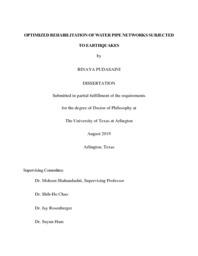
ATTENTION: The works hosted here are being migrated to a new repository that will consolidate resources, improve discoverability, and better show UTA's research impact on the global community. We will update authors as the migration progresses. Please see MavMatrix for more information.
Show simple item record
| dc.contributor.advisor | Shahandashti, Mohsen | |
| dc.creator | Pudasaini, Binaya | |
| dc.date.accessioned | 2022-01-20T17:34:35Z | |
| dc.date.available | 2022-01-20T17:34:35Z | |
| dc.date.created | 2019-08 | |
| dc.date.issued | 2019-08-27 | |
| dc.date.submitted | August 2019 | |
| dc.identifier.uri | http://hdl.handle.net/10106/30154 | |
| dc.description.abstract | Earthquakes in the past and in the recent times have demonstrated the extreme vulnerability of the water pipe networks. The impacts of such earthquakes on the water supply network can lead to significant direct and indirect losses. These losses highlight the critical need for seismic rehabilitation of water pipe network. Despite such criticality, water supply network managers are often constrained in what they can do with the limited rehabilitation budget that they have access to. Majority of current models dealing with seismic vulnerability assessment of water pipes do not provide actionable insights to the utility managers for the seismic rehabilitation of their networks. Furthermore, a few models that actually provide some rehabilitation decision-support are limited by their simplifications and the use of sub-optimal optimization techniques. In this regard, this research was conducted to integrate a genetic algorithm-based optimization with a component-level seismic vulnerability assessment model and hydraulic modeling of the pipe network to identify critical pipes for proactive seismic rehabilitation of water pipe networks when utilities can only rehabilitate a finite length of pipes, to integrate a simulated annealing-based optimization with a component-level seismic vulnerability assessment model and hydraulic modeling of the pipe network to identify critical pipes for proactive seismic rehabilitation of water pipe networks when utilities have a limited budget for rehabilitation, and to evaluate the performance of a wide range of resilience metrics for optimization of seismic rehabilitation of water pipe networks.
The results of this research show that the metaheuristic-based optimization methods such as genetic algorithm and simulated annealing demonstrate a really good performance when used to formulate an optimized policy for the seismic optimization of the water pipe network when the rehabilitation is subject to rehabilitation constraints. The results also shown that the metaheuristic-based optimization demonstrate superior performance when compared to the results of the latest methodology in literature. The results also show that the use of some graph theory based objective functions to maximize the post-earthquake serviceability of water pipe network can help reduce significant runtime of the optimization and can be used as surrogates for the computationally intensive hydraulics-based objectives.
The outcomes of this research offer novel contributions to field of decision science regarding the optimized seismic rehabilitation of water pipe network. Similarly, the outcomes are also valuable additions to the state practice since the resulting models can be highly useful to the utility managers for maximizing the post-earthquake serviceability of water pipe networks when the managers invest in the seismic rehabilitation of the water pipe networks. | |
| dc.format.mimetype | application/pdf | |
| dc.language.iso | en_US | |
| dc.subject | Earthquakes | |
| dc.subject | Rehabilitation | |
| dc.subject | Water pipelines | |
| dc.subject | Pipe networks | |
| dc.subject | Genetic algorithm | |
| dc.subject | Simulated annealing | |
| dc.subject | Monte Carlo simulation | |
| dc.subject | Optimization | |
| dc.subject | Graph theory | |
| dc.subject | Seismic effects | |
| dc.subject | Meta-heuristics | |
| dc.title | Optimized Rehabilitation of Water Pipe Networks Subjected to Earthquakes | |
| dc.type | Thesis | |
| dc.date.updated | 2022-01-20T17:34:35Z | |
| thesis.degree.department | Civil Engineering | |
| thesis.degree.grantor | The University of Texas at Arlington | |
| thesis.degree.level | Doctoral | |
| thesis.degree.name | Doctor of Philosophy in Civil Engineering | |
| dc.type.material | text | |
| dc.creator.orcid | 0000-0001-9892-0662 | |
Files in this item
- Name:
- PUDASAINI-DISSERTATION-2019.pdf
- Size:
- 3.733Mb
- Format:
- PDF
This item appears in the following Collection(s)
Show simple item record


